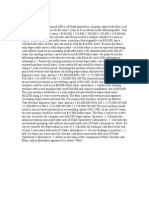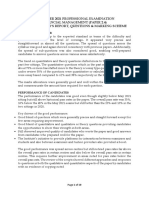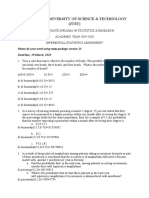GNB14 e CH 12 Exam
GNB14 e CH 12 Exam
Uploaded by
a_elsaiedCopyright:
Available Formats
GNB14 e CH 12 Exam
GNB14 e CH 12 Exam
Uploaded by
a_elsaiedOriginal Title
Copyright
Available Formats
Share this document
Did you find this document useful?
Is this content inappropriate?
Copyright:
Available Formats
GNB14 e CH 12 Exam
GNB14 e CH 12 Exam
Uploaded by
a_elsaiedCopyright:
Available Formats
Garrison 14e Practice Exam Chapter 12
Print these pages. Answer each of the following questions, explaining your answers or showing your work, and then compare your solutions to those provided at the end of the practice exam. 1. Carley Company produces 2,000 parts per year, which are used in the assembly of one of its products. The variable cost of manufacturing each part is $64 and the fixed manufacturing costs total $36 per unit for a total unit product cost of $100. The part can be purchased from an outside supplier at $80 per unit. If the part is purchased from the outside supplier, two-thirds of the fixed manufacturing costs can be eliminated. Part (a) Which costs are relevant to this decision? Why?
Part (b) What would the annual impact on the companys net operating income be as a result of buying the part from the outside supplier?
2. The management of Bayside Company is considering whether one of the departments in its retail stores should be eliminated. The contribution margin in the department is $150,000 per year. Fixed expenses allocated to the department are $130,000 per year. It is estimated that $120,000 of these fixed expenses will be eliminated if the department is discontinued. Part (a) Which costs are irrelevant to this decision?
Part (b) If the department is eliminated, what will be the impact on the companys overall net operating income?
3. Nichols Company, which manufactures a single product, is operating at full capacity of 20,000 units per month. The follow unit costs relate to the manufacture of this product: Manufacturing: Direct materials Direct labor Variable overhead Fixed overhead Selling and administrative: Variable Fixed
$2.00 4.00 1.00 1.80 3.00 1.20
The company has 100 units left over from last year which have small defects and which will have to be sold at a reduced price as scrap. This would have no effect on the company's other sales. The variable selling and administrative costs would have to be incurred to sell the defective units. What cost is relevant as a guide for setting a minimum price on these defective units?
4. Thurston Company sells its product for $42 per unit. The companys unit product cost based on the full capacity of 400,000 units is as follows. Direct materials Direct labor Manufacturing overhead Unit product cost $ 8 10 12 $30
A special order offering to buy 40,000 units has been received from a foreign distributor. The only selling costs that would be incurred on this order would be $6 per unit for shipping. The company has sufficient idle capacity to manufacture the additional units. Two-thirds of the manufacturing overhead is fixed and would not be affected by this order. Assume that direct labor is an avoidable cost in this decision. In negotiating a price for the special order, what is the minimum acceptable selling price per unit?
5. Sandstrom Company is a small family business that produces wooden plaques and trophies: Plaques $18 12 $ 6 33% Trophies $15 8 $ 7 47%
Selling price per unit Variable cost per unit Contribution margin per unit Contribution margin ratio
The company only has one machine, a sander, to sand the wood that is used for the plaques and trophies. Generally, the wood required for each plaque takes 0.25 hour to sand, while the word required for each trophy takes 0.50 hour to sand. Based on the constraint related to the machine time, which product should be emphasized if only limited machine time is available?
GNB 14e Practice Exam Solutions Chapter 12
1. Part (a) Solution (Learning Objective 1): The product costs related to making the parts that can be eliminated are the variable manufacturing costs ($64 per unit) and two-thirds of the fixed manufacturing costs (2/3 x $36 = $24) for a total of $88 (or $64 + $24) per unit. Those are the costs that are relevant to the make decision. The cost that is relevant to the buy decision is the purchase price of $80 per unit. Since one-third of the fixed manufacturing costs cannot be eliminated, those costs are not relevant to this decision. Part (b) Solution (Learning Objective 3): The annual impact on the companys net operating income as a result of buying the part from the outside supplier is determined as follows. Production Cost per Unit $ 64 36 $100 Per Unit Differential Costs Make Buy $64 $80 (24) $56 $8 Total Differential Costs2,000 Units Make Buy $128,000 $160,000 (48,000) $128,000 $112,000 $16,000
Variable manufacturing costs Fixed manufacturing costs Outside purchase price Fixed manufacturing costs eliminated Total cost Difference in favor of purchasing
$64
2. Part (a) Solution (Learning Objective 1): The common fixed costs of $10,000 (or $130,000 - $120,000) are irrelevant to this decision. Part (a) Solution (Learning Objective 2): CM that would be lost if department is discontinued Less fixed costs that can be avoided if department is discontinued Increase (decrease) in net operating income $(150,000) 120,000 $ (30,000)
Based on this information alone, because the companys net operating income would decrease by $30,000 per year, management should not eliminate this department.
3. Solution (Learning Objective 3): A relevant cost is a cost that differs between alternatives in a decision-making situation. Since the variable selling and administrative expenses of $3.00 per unit would need to be incurred to sell the defective units, they are relevant to the decision and should be used as a guide for setting the minimum price on these defective units. Note that none of the other per unit costs would be relevant as a guide for setting the minimum price on the defective units. The four types manufacturing costs listed above are sunk costs (i.e., a cost that has already been incurred and that cannot be changed by any decision made now or in the future) and, as such, are not relevant to this decision. The fixed selling and administrative expenses is a common fixed cost (i.e., a cost that supports the operations of more than one segment of an organization and is not avoidable in whole or in part by eliminating any one segment) and, as such, are not relevant to this decision.) 4. Solution (Learning Objective 4): The minimum acceptable selling price per unit is determined as follows. Direct materials Direct labor Variable manufacturing overhead ($12 x 1/3) Variable selling costs (shipping) Minimum selling price $ 8 10 4 6 $28
5. Solution (Learning Objective 5): To evaluate a situation where there is a constrained resource, the contribution margin per unit of constrained resource should be calculated. While at first it appears the trophies should be emphasized based on the data given above, when the contribution margin per machine hour is computed, it appears the plaques should be emphasized, as follows. Contribution margin (CM) per unit Machine hours per unit (MH) CM per machine hour (CM MH) Plaques Trophies $ 6 $ 7 .25 .50 $ 24 $ 14
In other words, for each hour of machine time, the wood for four plaques can be sanded with a CM of $6 per plaque, for a total of $24 CM per machine hour. Alternatively, for each hour of machine time, the wood for two trophies can be sanded with a CM of $7 per trophy, for a total of $14 CM per hour of machine time. So with limited machine time, the plaques should be emphasized since more CM per machine hour will be realized.
You might also like
- Case 1 - Sample Solution - Stand20210713Document15 pagesCase 1 - Sample Solution - Stand20210713Vikaas PansheriaNo ratings yet
- Jiranna Healthcare'sDocument5 pagesJiranna Healthcare'sEllen MarkNo ratings yet
- IMT 58 Management Accounting M3Document23 pagesIMT 58 Management Accounting M3solvedcareNo ratings yet
- Chapter 8Document30 pagesChapter 8carlo knowsNo ratings yet
- Bab Vii BalandcorcardDocument17 pagesBab Vii BalandcorcardCela Lutfiana100% (1)
- Topic 7 - Financial Leverage - ExtraDocument57 pagesTopic 7 - Financial Leverage - ExtraBaby KhorNo ratings yet
- Multinational Finance-Tutorial 7 AsnwerDocument24 pagesMultinational Finance-Tutorial 7 Asnwerchun88100% (2)
- Book1Accounting WorksheetDocument2 pagesBook1Accounting WorksheetLien AuNo ratings yet
- F5 Handout 1 For Dec 2011Document18 pagesF5 Handout 1 For Dec 2011saeed@atcNo ratings yet
- Assignment 2Document16 pagesAssignment 2Aaqib NawazNo ratings yet
- STCBL Financial AnalysisDocument33 pagesSTCBL Financial AnalysisSonam K Gyamtsho67% (3)
- SOLUTION MAF603 - JAN 2018 Without TickDocument8 pagesSOLUTION MAF603 - JAN 2018 Without Tickanis izzatiNo ratings yet
- The Quaker Oats Company and Subsidiaries Consolidated Statements of IncomeDocument3 pagesThe Quaker Oats Company and Subsidiaries Consolidated Statements of IncomeNaseer AhmedNo ratings yet
- Target CostingDocument9 pagesTarget CostingRahul PandeyNo ratings yet
- Vdocuments - MX - Chapter 5 578590693cc3a PDFDocument43 pagesVdocuments - MX - Chapter 5 578590693cc3a PDFAmrita TamangNo ratings yet
- FCFF and FCFE QuestionsDocument4 pagesFCFF and FCFE Questionsaks171No ratings yet
- Chap 1Document22 pagesChap 1Zara Sikander33% (3)
- CH 20Document14 pagesCH 20KARISHMAATA2No ratings yet
- Abc 2018Document12 pagesAbc 2018vicent laurianNo ratings yet
- Chapter 03 TP EndDocument43 pagesChapter 03 TP EndMesfin MekuriaNo ratings yet
- Lecture # 12Document19 pagesLecture # 12bwcs1122No ratings yet
- Cost Ii CH 2Document23 pagesCost Ii CH 2TESFAY GEBRECHERKOSNo ratings yet
- Tutorial FinalDocument35 pagesTutorial FinalIzaLiaNo ratings yet
- Descriptive Ethical TheoriesDocument27 pagesDescriptive Ethical TheoriesBETHMI MITHARA JAYAWARDENANo ratings yet
- Cost & Management Accounting - Paper 7Document7 pagesCost & Management Accounting - Paper 7Turyamureeba JuliusNo ratings yet
- Chapters 11 and 12 EditedDocument13 pagesChapters 11 and 12 Editedomar_geryes0% (1)
- Question Bank (CHE-S508) PDFDocument5 pagesQuestion Bank (CHE-S508) PDFDHEERESH KUMARNo ratings yet
- Math Solution (Life Cycle Costing)Document26 pagesMath Solution (Life Cycle Costing)Kamrul HassanNo ratings yet
- Internal Test - 2 - FSA - QuestionDocument3 pagesInternal Test - 2 - FSA - QuestionSandeep Choudhary40% (5)
- Lecture 2 BEP Numericals AnswersDocument16 pagesLecture 2 BEP Numericals AnswersSanyam GoelNo ratings yet
- CVP AnalysisDocument7 pagesCVP AnalysisKat Lontok0% (1)
- Security Analysis & Portfolio Management: Risk & ReturnDocument27 pagesSecurity Analysis & Portfolio Management: Risk & Returnrahu007einstein56uNo ratings yet
- Cost of CapitalDocument56 pagesCost of CapitalJainNo ratings yet
- Financial Management IDocument58 pagesFinancial Management Igelango124419No ratings yet
- Monno Ceramic ValuationDocument47 pagesMonno Ceramic ValuationMahmudul HassanNo ratings yet
- Part 2Document16 pagesPart 2Emmeline BlairNo ratings yet
- Chicago Valve TemplateDocument5 pagesChicago Valve TemplatelittlemissjaceyNo ratings yet
- Cma August 2013 SolutionDocument66 pagesCma August 2013 Solutionফকির তাজুল ইসলামNo ratings yet
- The Basics of Capital Budgeting: Solutions To End-Of-Chapter ProblemsDocument9 pagesThe Basics of Capital Budgeting: Solutions To End-Of-Chapter ProblemsTayeba AnwarNo ratings yet
- 4a. Capital BudgetingDocument6 pages4a. Capital BudgetingShubhrant ShuklaNo ratings yet
- 2011-02-03 230149 ClarkupholsteryDocument5 pages2011-02-03 230149 ClarkupholsteryJesus Cardenas100% (1)
- AFM Lecture 11Document24 pagesAFM Lecture 11Alseraj TechnologyNo ratings yet
- Chapter 5Document43 pagesChapter 5Sajid AliNo ratings yet
- Corp Finance Group One Course Work (Final)Document27 pagesCorp Finance Group One Course Work (Final)jonas sserumagaNo ratings yet
- November 2021 Professional Examination Financial Management (Paper 2.4) Chief Examiner'S Report, Questions & Marking SchemeDocument19 pagesNovember 2021 Professional Examination Financial Management (Paper 2.4) Chief Examiner'S Report, Questions & Marking SchemeAsaamah John AsumyusiaNo ratings yet
- Chapter-14: Multinational Capital BudgetingDocument14 pagesChapter-14: Multinational Capital BudgetingAminul Islam AmuNo ratings yet
- Assignment Session 7Document9 pagesAssignment Session 7Custer CoNo ratings yet
- C14 - Tutorial Answer PDFDocument5 pagesC14 - Tutorial Answer PDFJilynn SeahNo ratings yet
- Solved ProblemsDocument24 pagesSolved ProblemsSammir MalhotraNo ratings yet
- Final Doc of Management AssignmentDocument10 pagesFinal Doc of Management AssignmentrasithapradeepNo ratings yet
- All 12 Assignment AnswersDocument5 pagesAll 12 Assignment AnswersShafici CqadirNo ratings yet
- Inventory Control ModelDocument17 pagesInventory Control ModelAnn Okoth100% (1)
- Overheads Revision PDFDocument9 pagesOverheads Revision PDFSurajNo ratings yet
- Basic STD CostingDocument5 pagesBasic STD CostingSajidZiaNo ratings yet
- Accounting and Finance Assi-IIDocument7 pagesAccounting and Finance Assi-IISisay GudisaNo ratings yet
- Linear ProgrammingDocument3 pagesLinear ProgrammingTito Banerjee100% (1)
- Costing System at Plastim CorporationDocument10 pagesCosting System at Plastim CorporationKumar SunnyNo ratings yet
- Garrison (Asian Edition) Practice Exam - Chapter 14Document5 pagesGarrison (Asian Edition) Practice Exam - Chapter 14mariko1234No ratings yet
- CH 11 Quiz KeyDocument7 pagesCH 11 Quiz KeyMatt ManiscalcoNo ratings yet
- Garrison (Asian Edition) Practice Exam - Chapter 14Document11 pagesGarrison (Asian Edition) Practice Exam - Chapter 14mariko1234No ratings yet
- ACCT 434 Final Exam (Updated)Document12 pagesACCT 434 Final Exam (Updated)DeVryHelpNo ratings yet
- DeVry ACCT 434 Final Exam 1 100% Correct AnswerDocument9 pagesDeVry ACCT 434 Final Exam 1 100% Correct AnswerDeVryHelpNo ratings yet
- Grade 5 NS & Tech Term 2 Controlled TestDocument8 pagesGrade 5 NS & Tech Term 2 Controlled TestsbongahemkayngwaneNo ratings yet
- One Hundred Percent Construction & Developement Corporation: Bella C. TiotangcoDocument1 pageOne Hundred Percent Construction & Developement Corporation: Bella C. TiotangcokenkenmusicNo ratings yet
- Market Research On Sleeping PodsDocument5 pagesMarket Research On Sleeping PodsolayemimariamoyindamolaNo ratings yet
- SMC Nov2023, Kolkata OfficeDocument12 pagesSMC Nov2023, Kolkata OfficeSib MktgNo ratings yet
- Economics of LoveDocument5 pagesEconomics of LoveAmartya BagNo ratings yet
- Mutually Exclusive ProjectsDocument39 pagesMutually Exclusive ProjectsRAMRAJ CHIMOURIYANo ratings yet
- Mẫu hợp đồng ngoại thương bằng Tiếng Anh: ContractDocument3 pagesMẫu hợp đồng ngoại thương bằng Tiếng Anh: ContractTrinh ngoc thao Trinh ngoc thaoNo ratings yet
- Crazytoken 2Document8 pagesCrazytoken 2GregNo ratings yet
- Nexon Pe deDocument2 pagesNexon Pe deRupesh MishraNo ratings yet
- Quality Checklist For Site Works: 17 Wet-Area Waterproofing TaskDocument1 pageQuality Checklist For Site Works: 17 Wet-Area Waterproofing Taskadnan-651358No ratings yet
- Vglove-Medical Glove BrochureDocument20 pagesVglove-Medical Glove BrochureNguyễn TuấnNo ratings yet
- Agri Tourism Maharashtra Statistics 2022 - 2023Document5 pagesAgri Tourism Maharashtra Statistics 2022 - 2023Pandurang TawareNo ratings yet
- Personal Contacts: Good Morning. Mr. Berneilke. Nice To See You Again Good Morning Mrs. FungDocument8 pagesPersonal Contacts: Good Morning. Mr. Berneilke. Nice To See You Again Good Morning Mrs. FungLiseth Marcela Garcia BañoNo ratings yet
- Data Sheet A1 A15 BidimDocument2 pagesData Sheet A1 A15 BidimEmil ElkinNo ratings yet
- Reading Passage 1: IELTS Practice Tests PlusDocument16 pagesReading Passage 1: IELTS Practice Tests PlusNguyen Lan AnhNo ratings yet
- Process Costing Short QuizDocument5 pagesProcess Costing Short QuizGenithon PanisalesNo ratings yet
- Ob07 082023Document140 pagesOb07 082023Adnan MirzaNo ratings yet
- Apollo Medicine InvoiceJan 20 2024 22 01Document1 pageApollo Medicine InvoiceJan 20 2024 22 01goodmorningviewersNo ratings yet
- Ga Drg.Document1 pageGa Drg.sparkCENo ratings yet
- Opportunity Cost: James M. BuchananDocument4 pagesOpportunity Cost: James M. BuchananAndres Felipe Arguelles PinedaNo ratings yet
- TDS0137-01 PCU010 Pneumatic Low PressureDocument2 pagesTDS0137-01 PCU010 Pneumatic Low PressureElias MaximilianoNo ratings yet
- BHCN Employment Growth and Economic Benefit Assessment UrbisDocument30 pagesBHCN Employment Growth and Economic Benefit Assessment UrbisjonNo ratings yet
- Popcorn Lamb Amigurumi Crochet PDF Free PatternDocument7 pagesPopcorn Lamb Amigurumi Crochet PDF Free Patternami arinta100% (1)
- Busmath Week 3Document18 pagesBusmath Week 3Doffannoel SihotangNo ratings yet
- The Journey To Series A in EuropeDocument24 pagesThe Journey To Series A in EuropeMohammed ShalawyNo ratings yet
- Andreea Geana HMRC - About You ConfirmationDocument2 pagesAndreea Geana HMRC - About You Confirmationandreea.gnaNo ratings yet
- Thivakaran Enterprise KK Praba 1Document28 pagesThivakaran Enterprise KK Praba 1vdj kumarNo ratings yet
- Surrrender PDFDocument2 pagesSurrrender PDFMaaz Ahmad KhanNo ratings yet

























































































